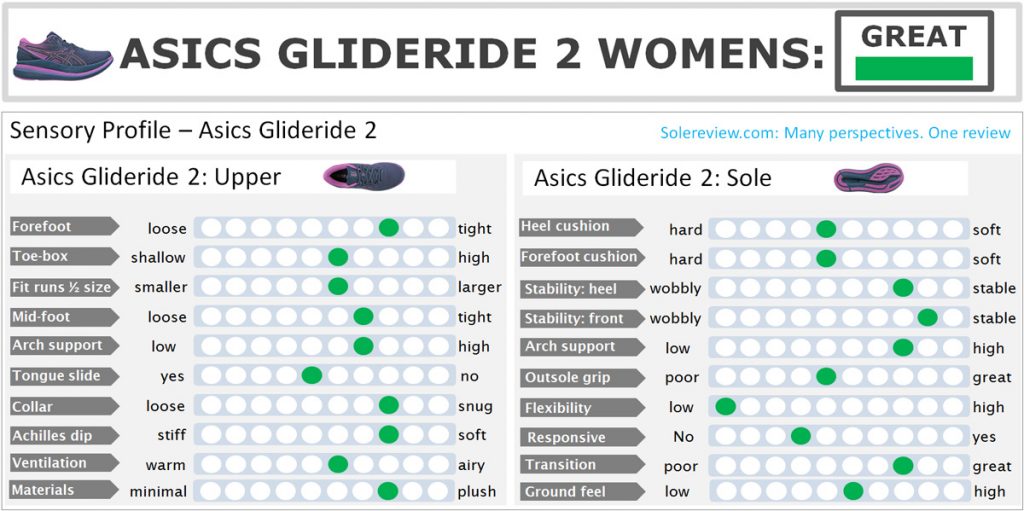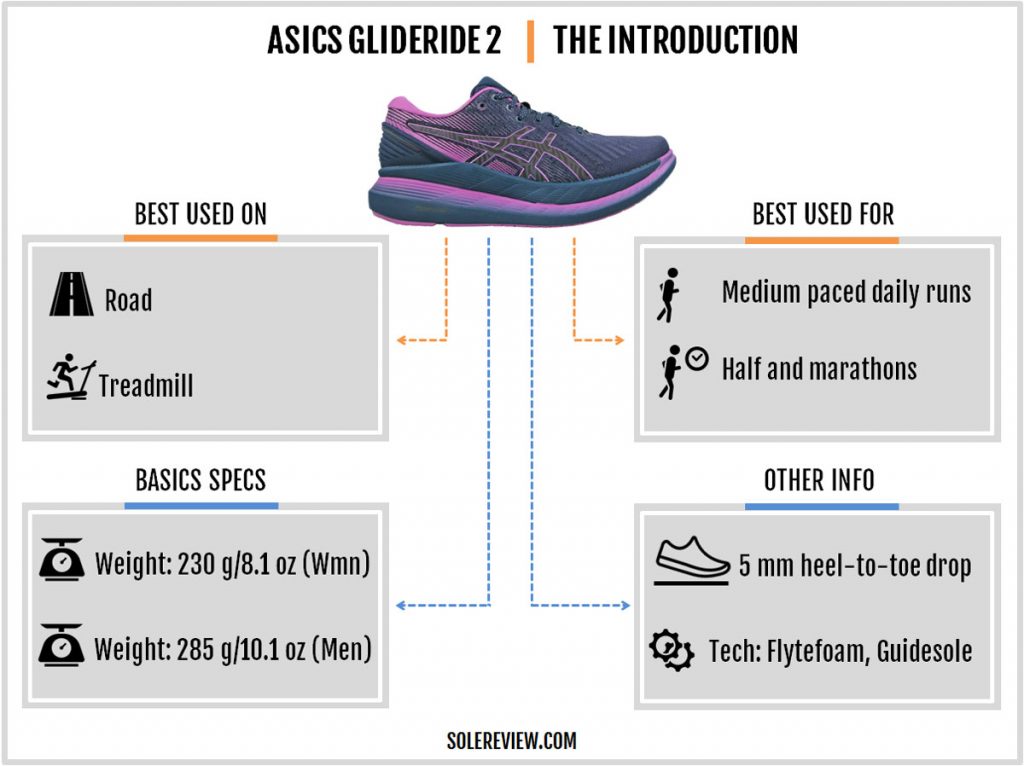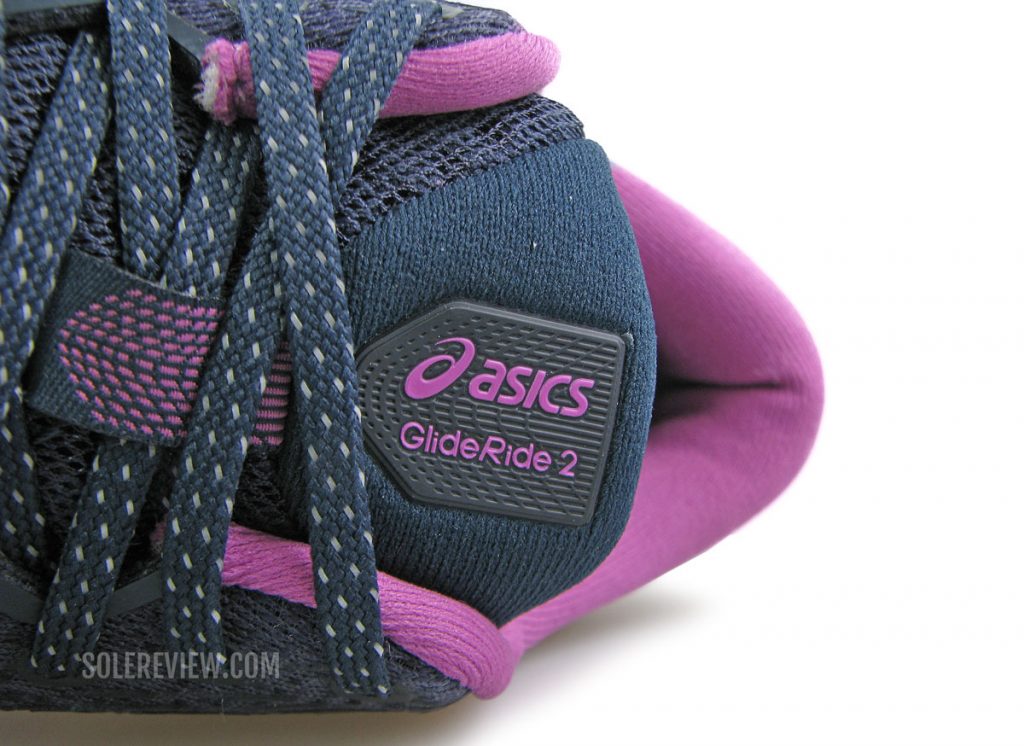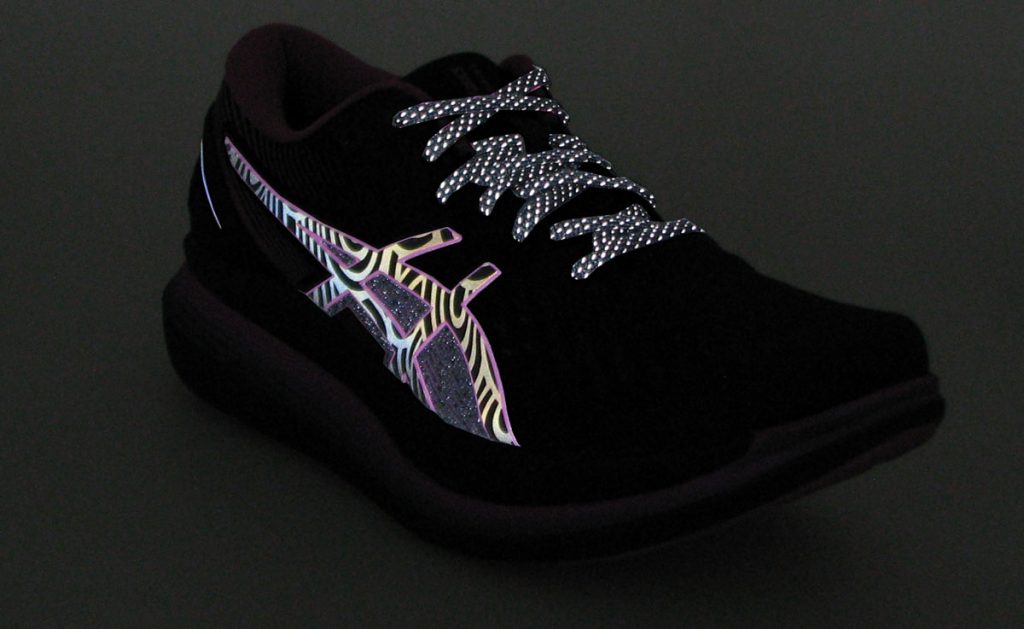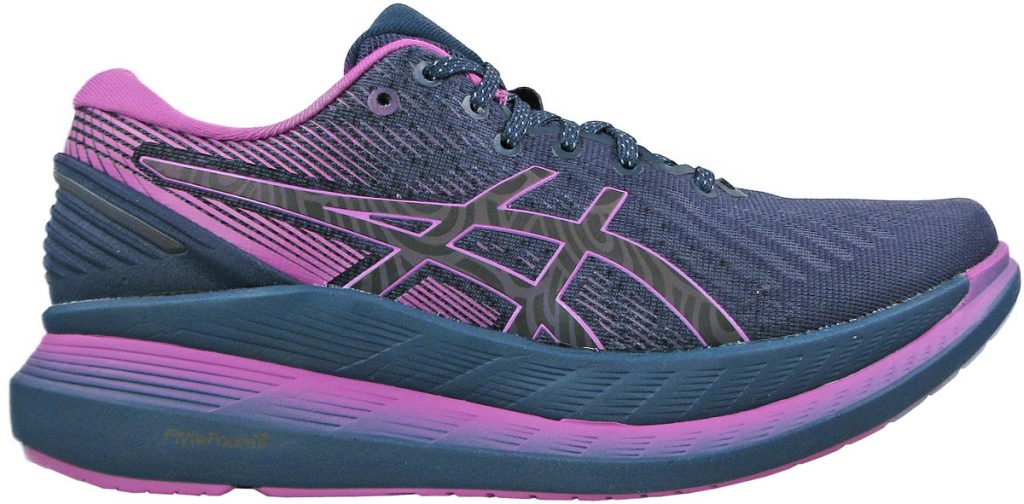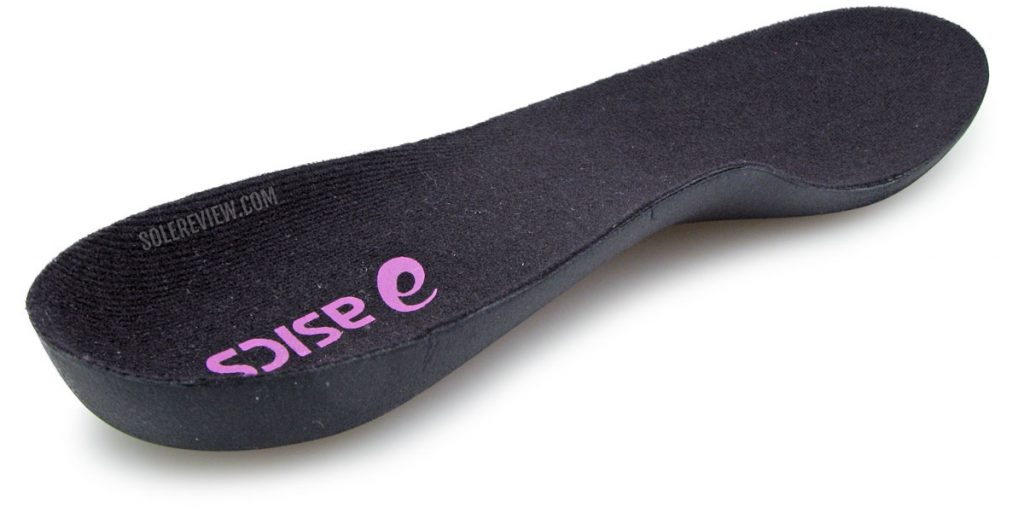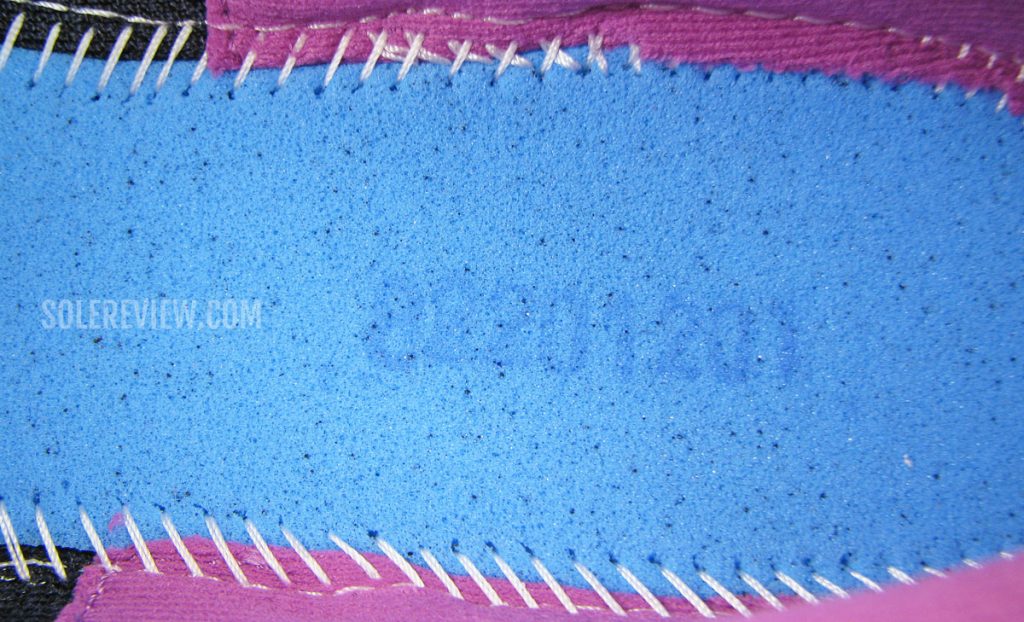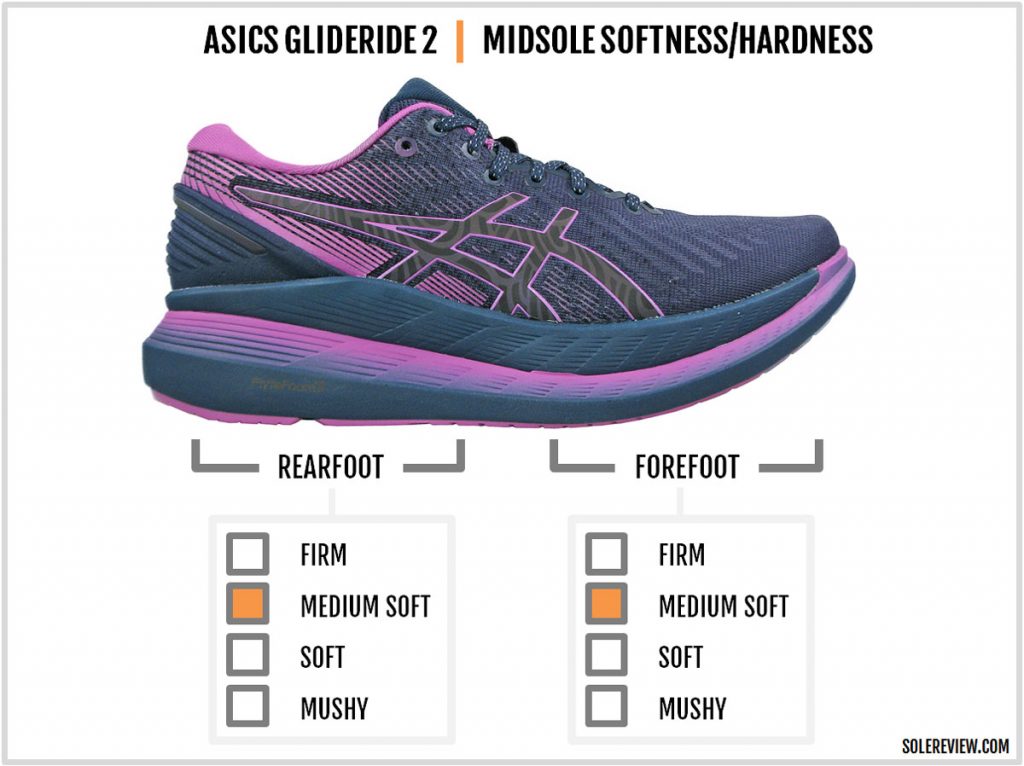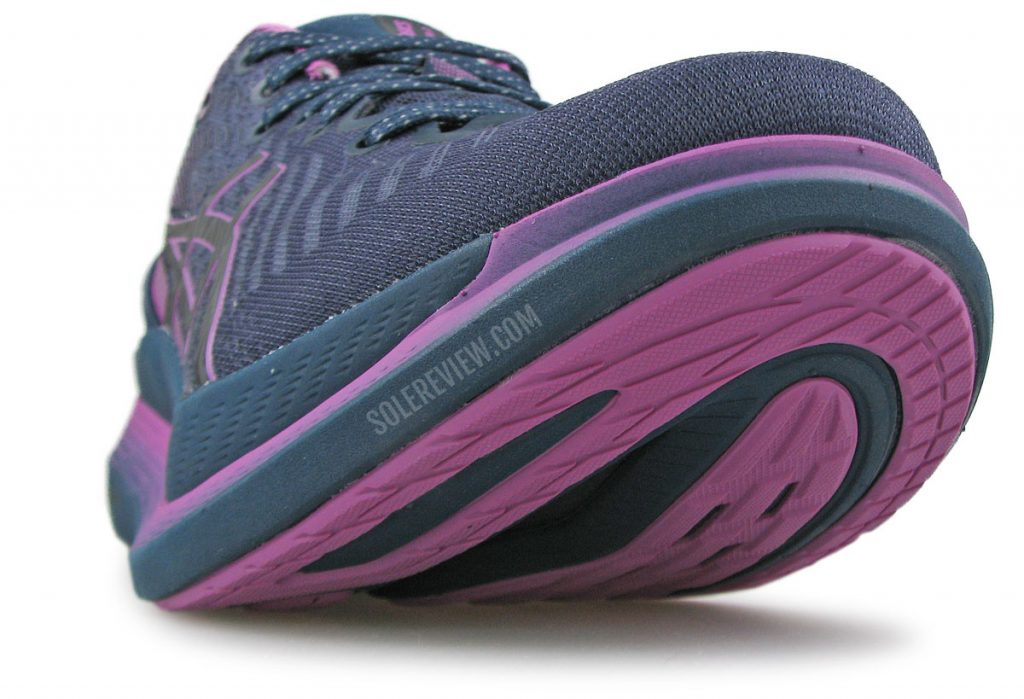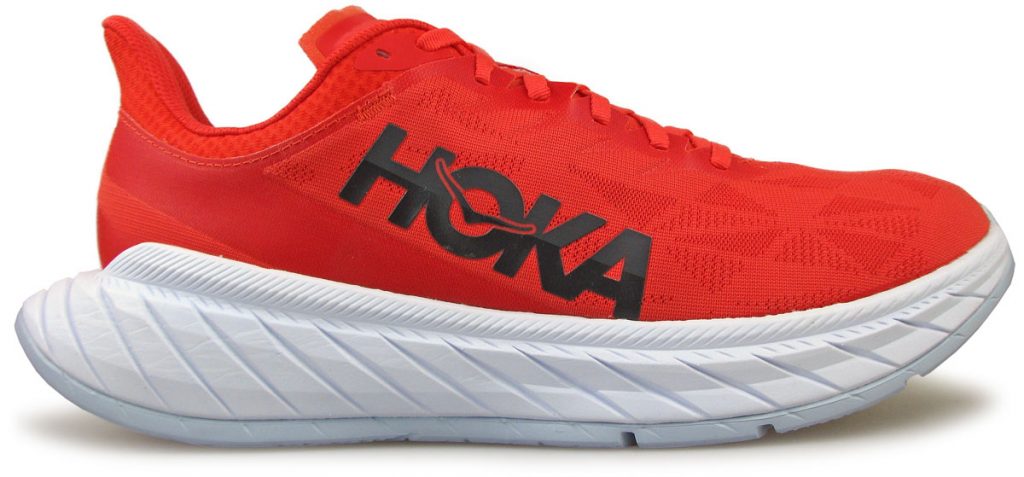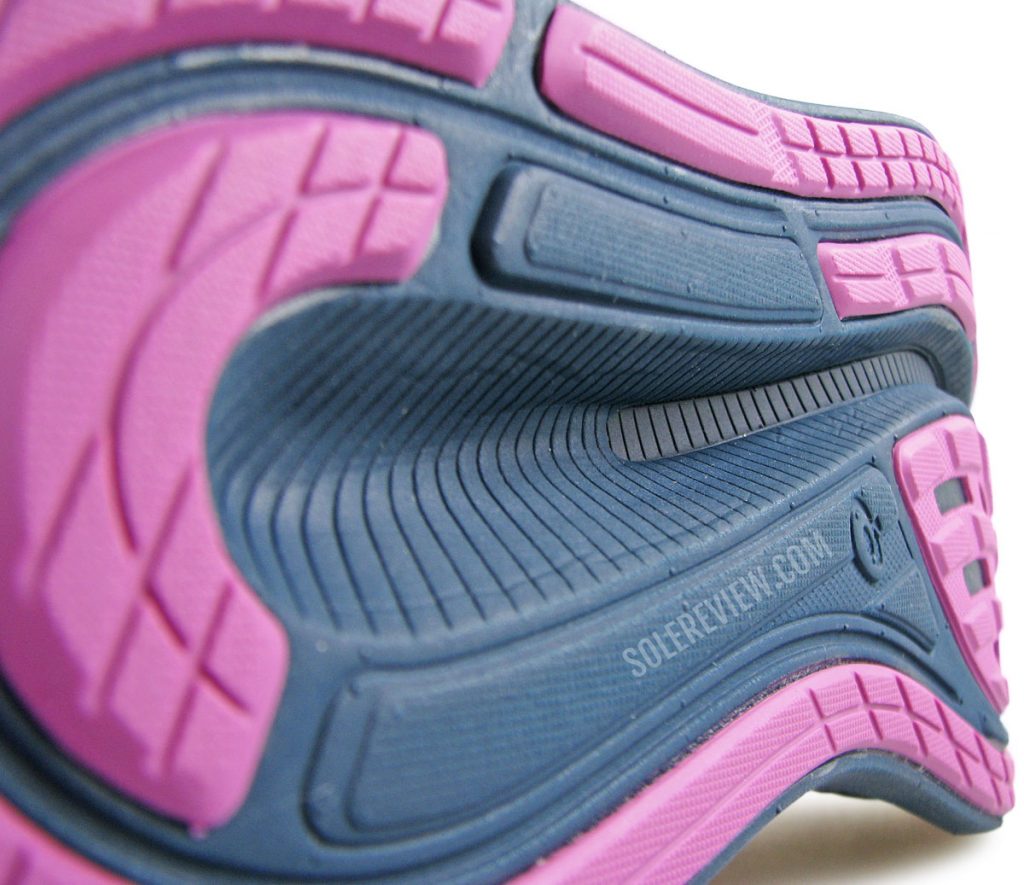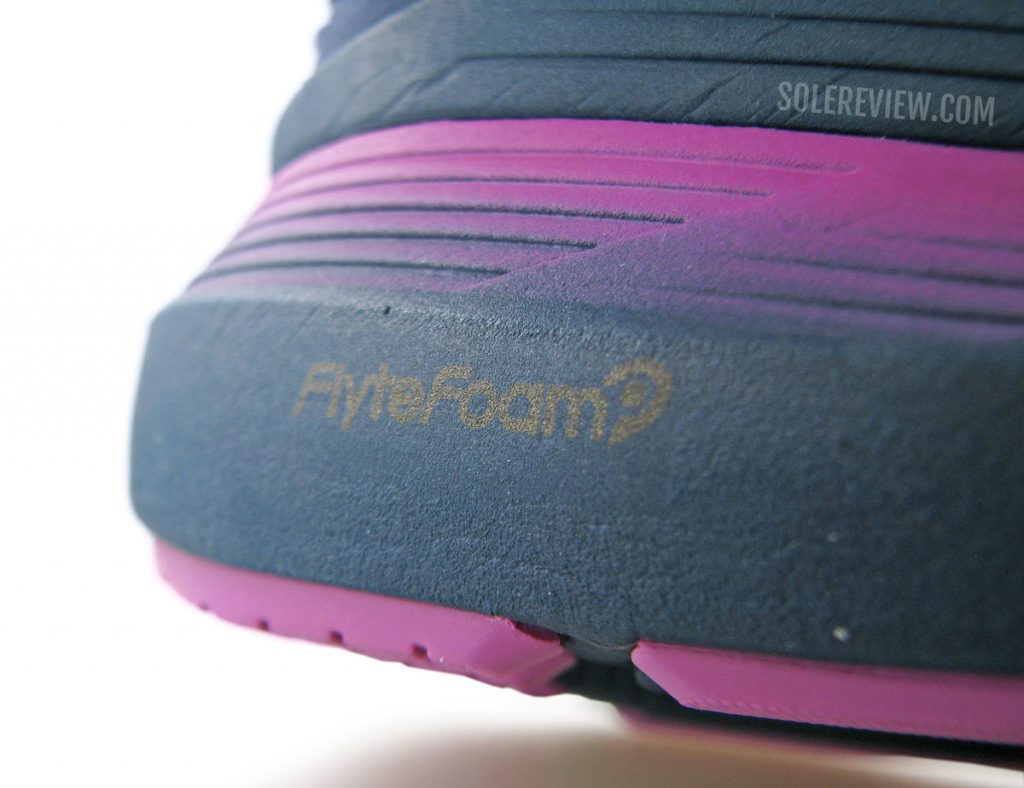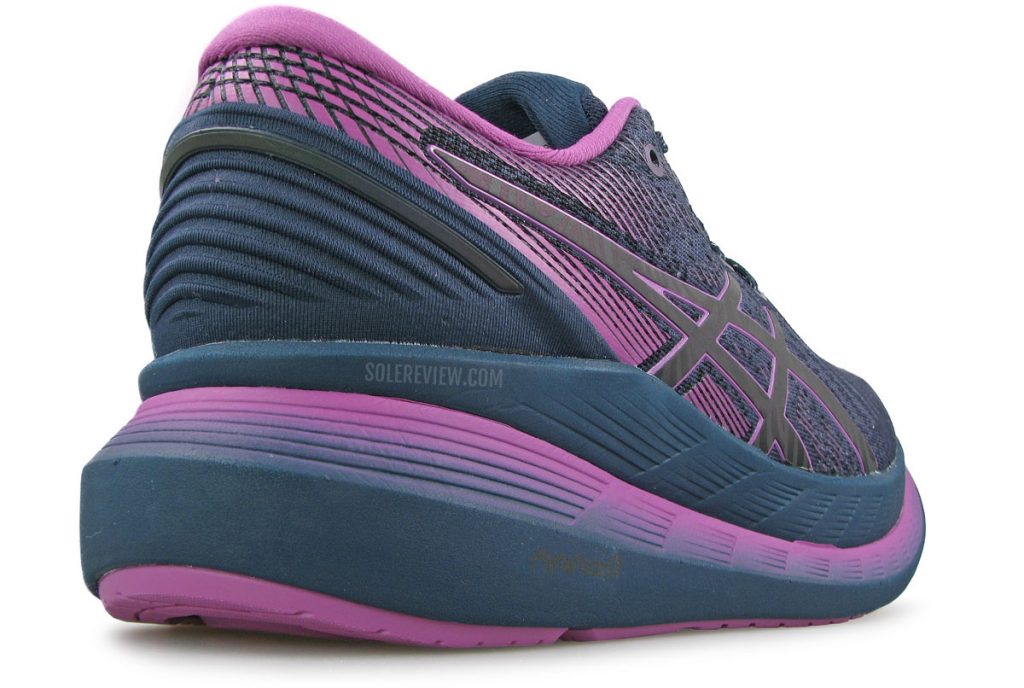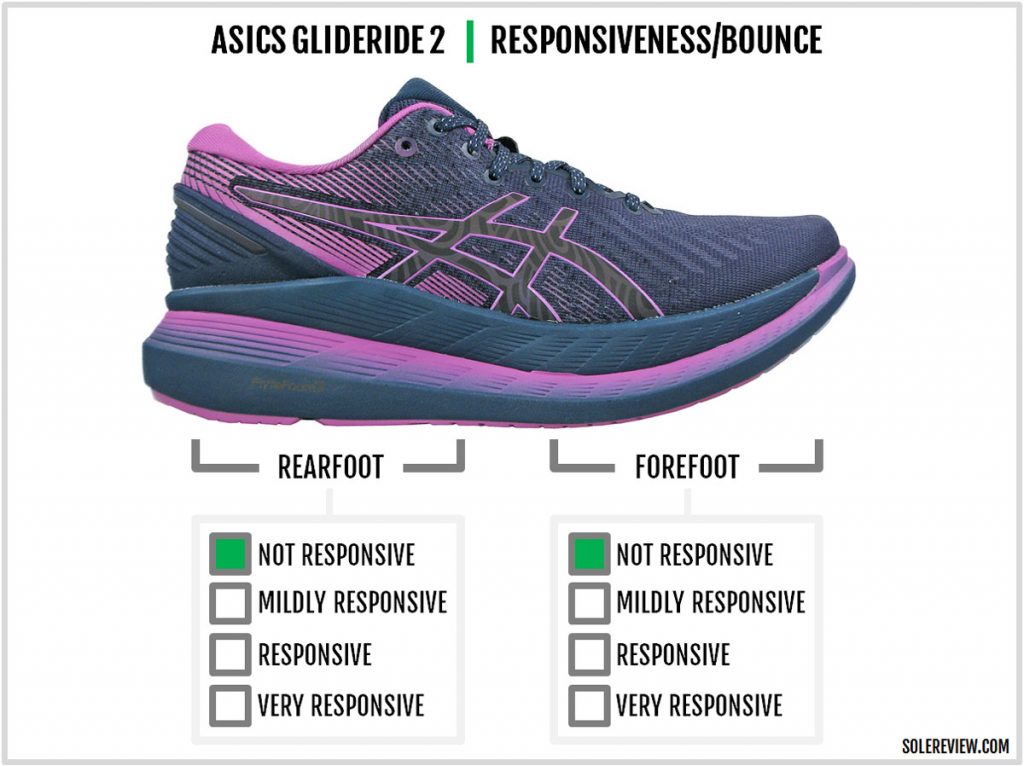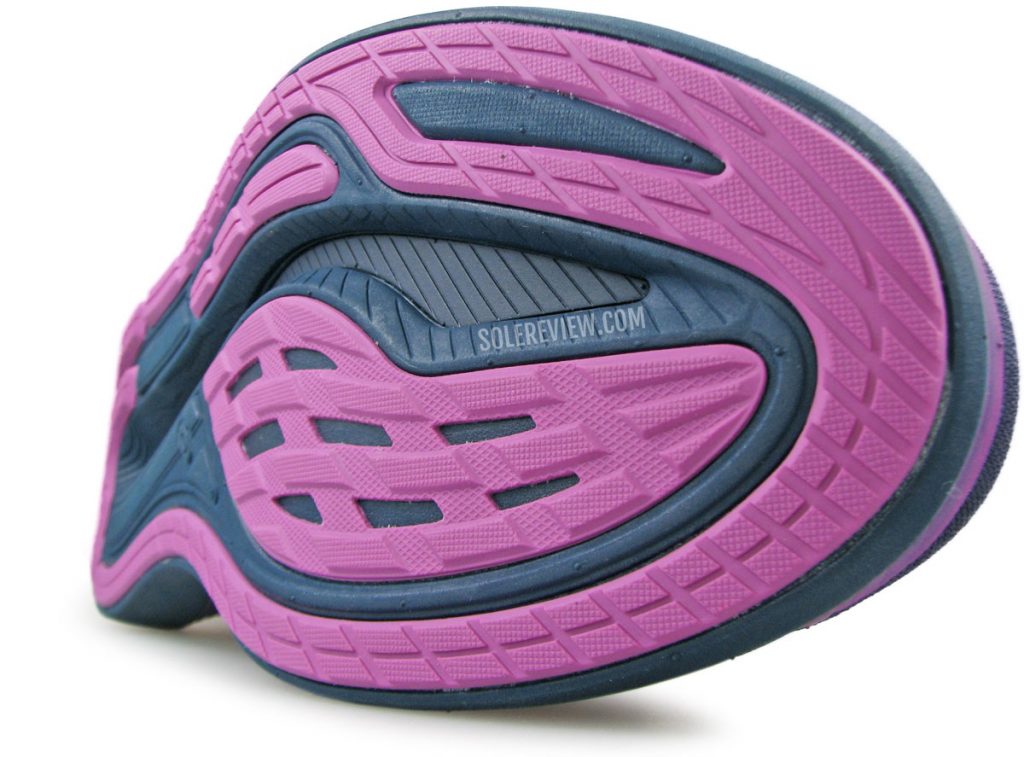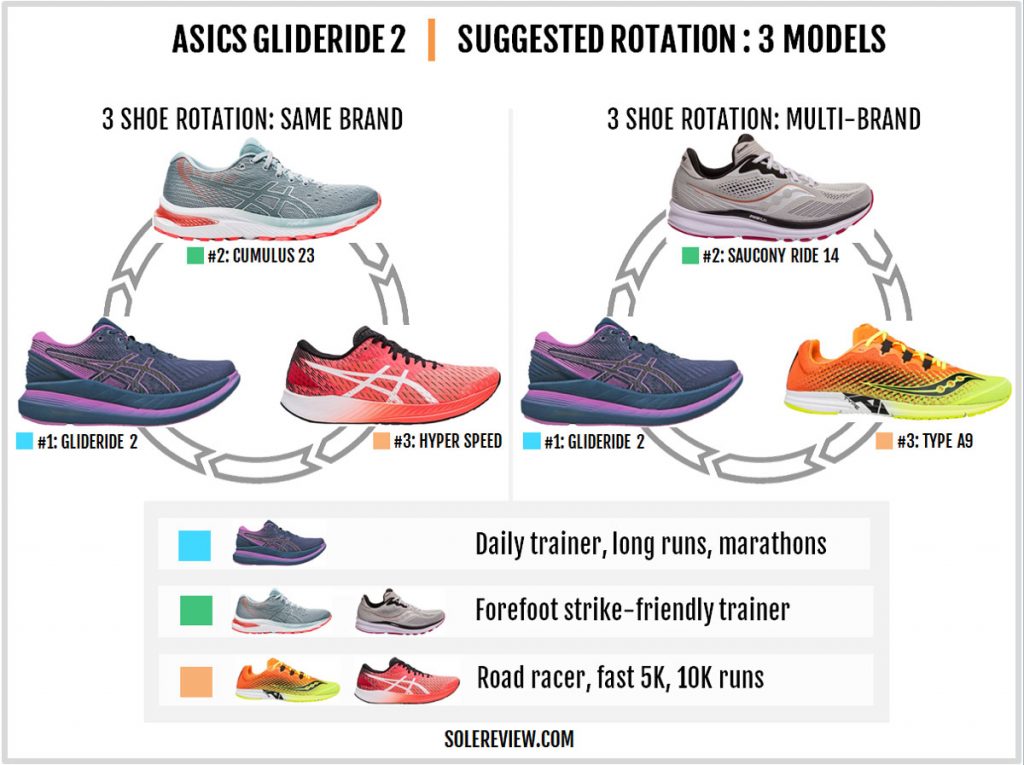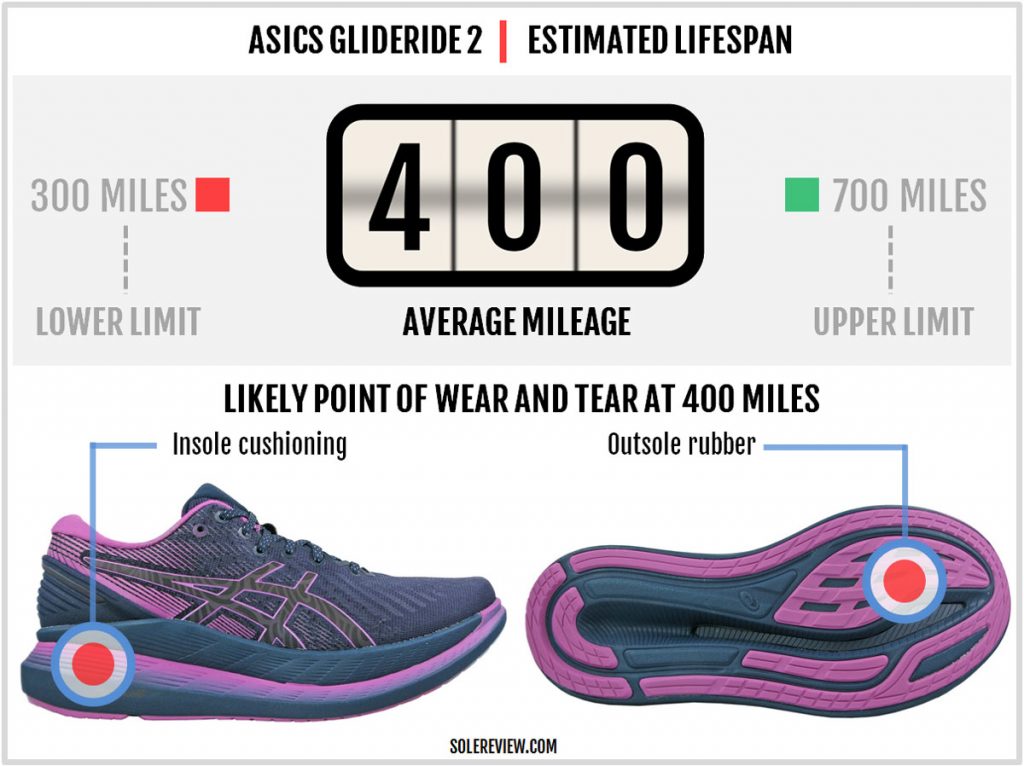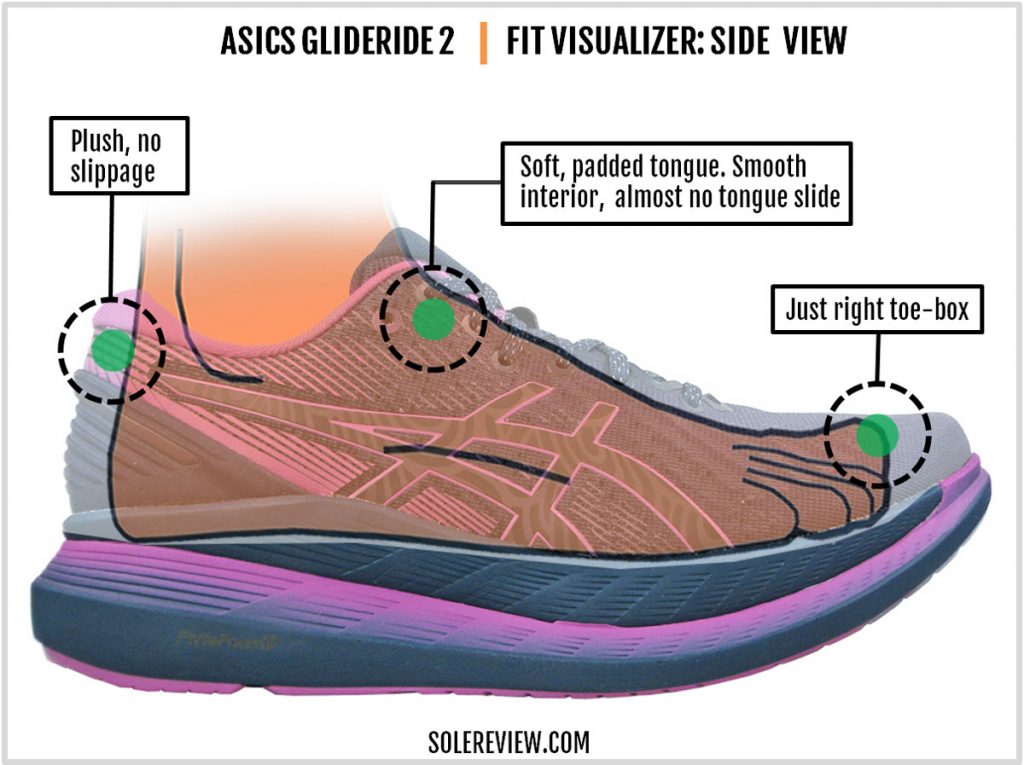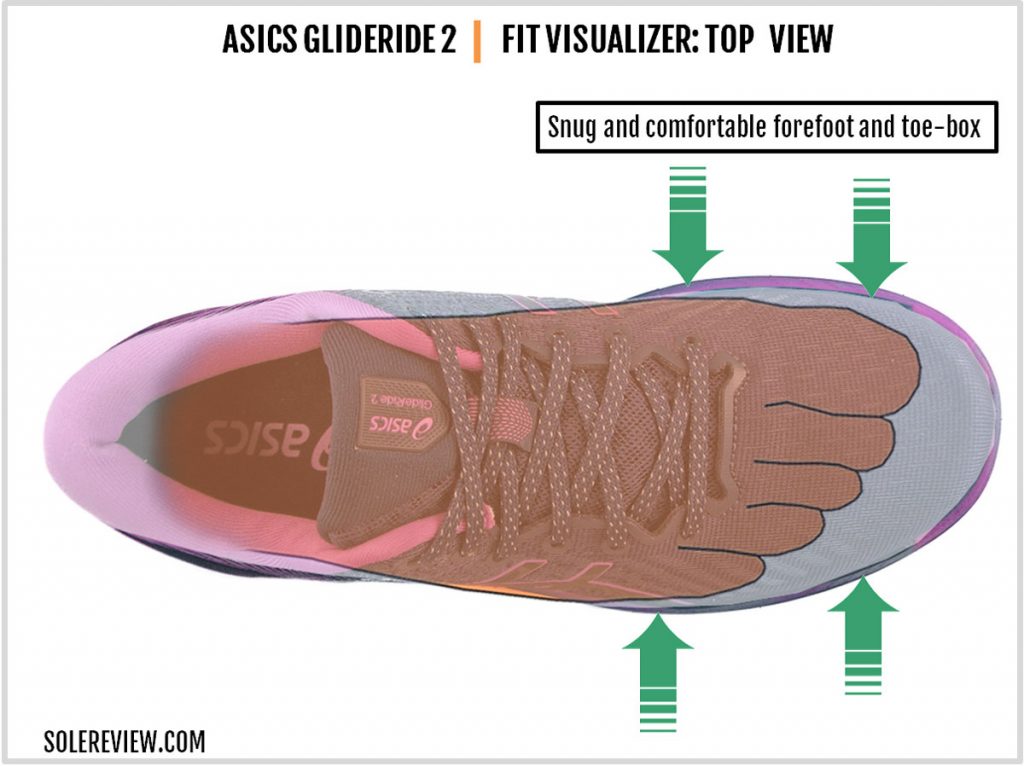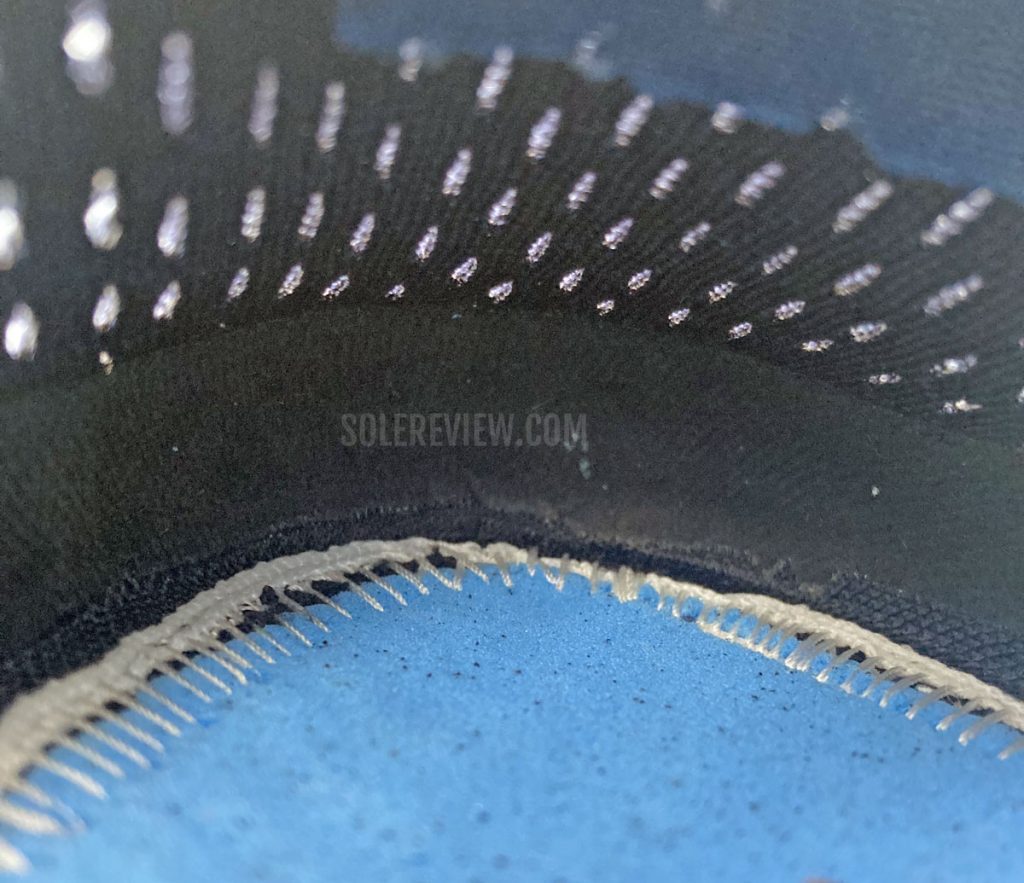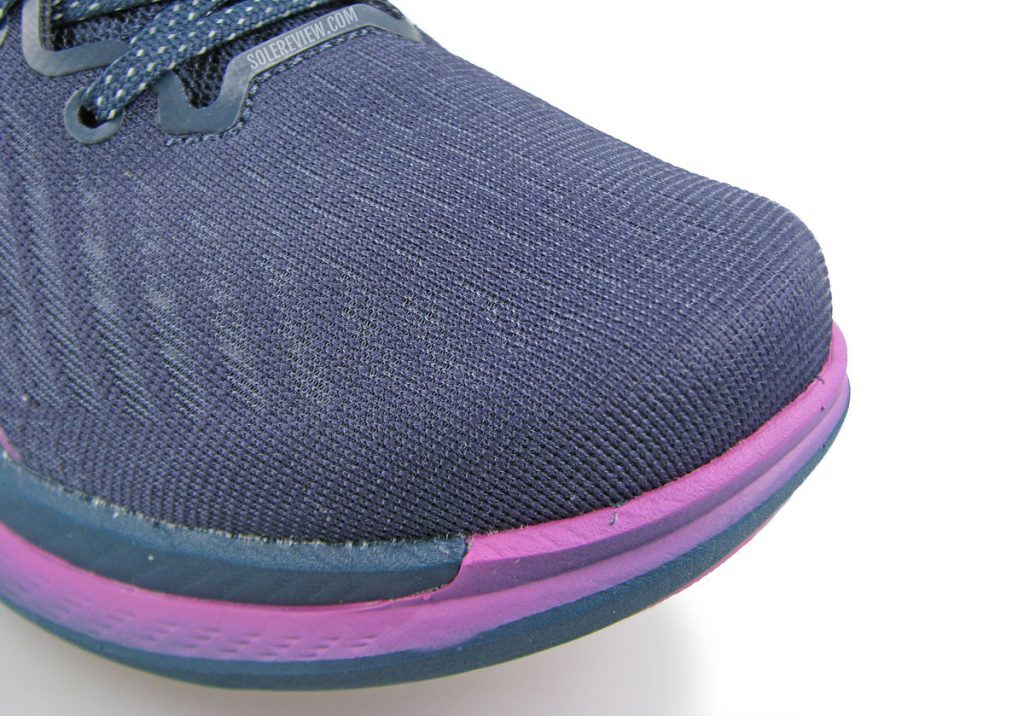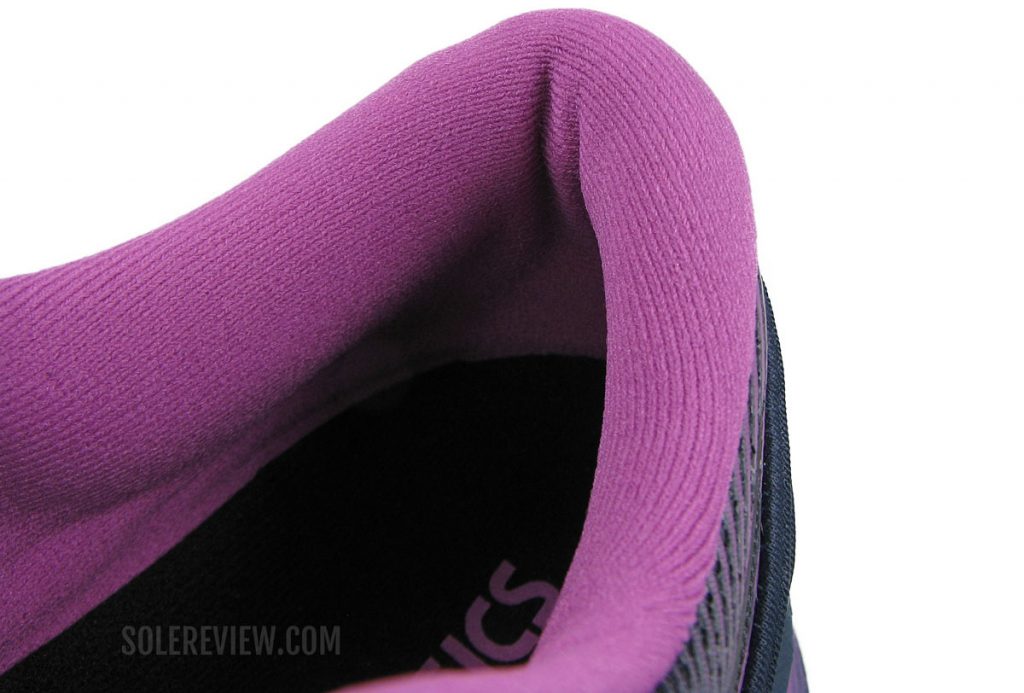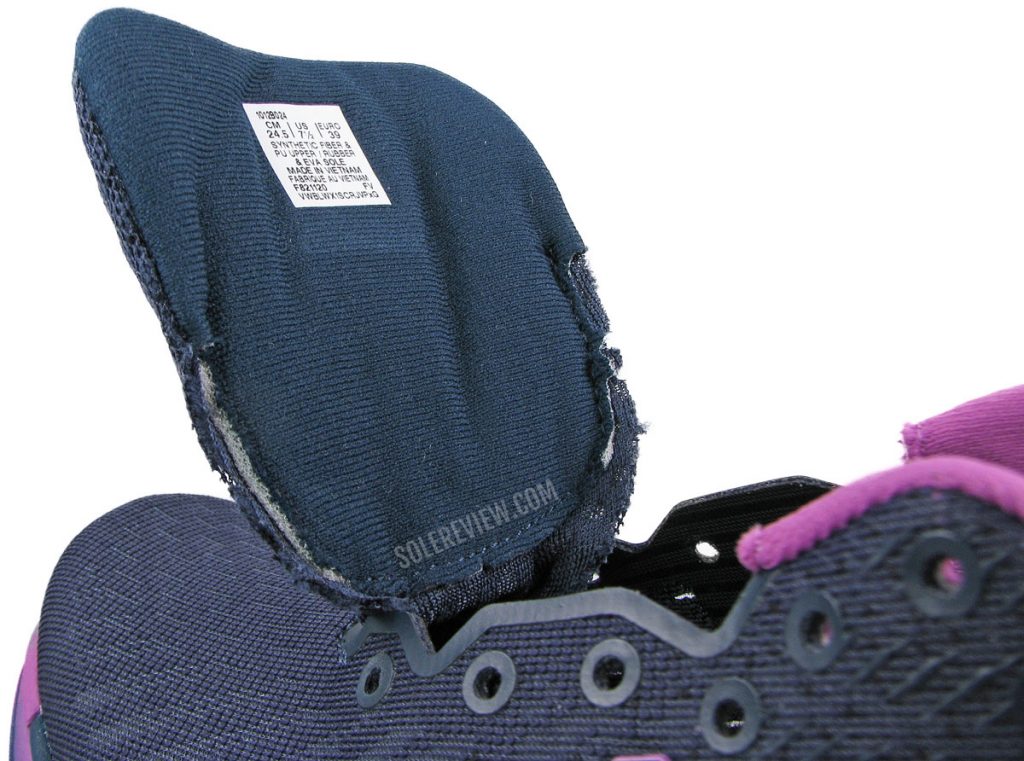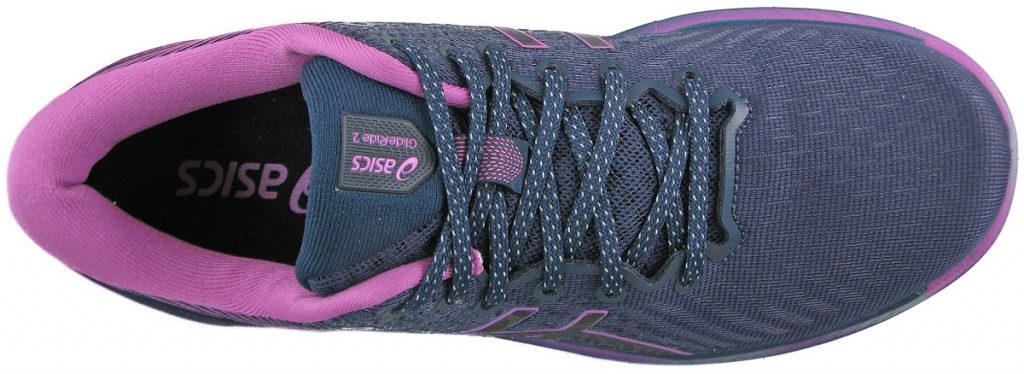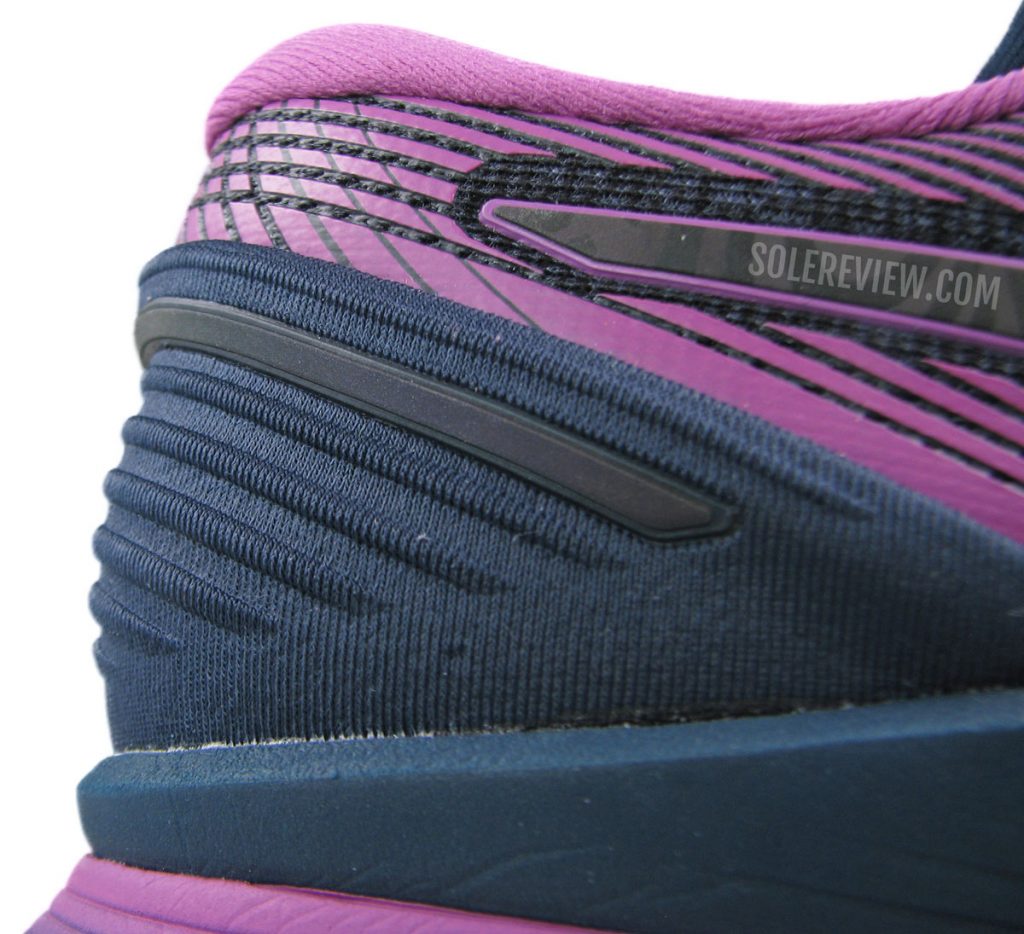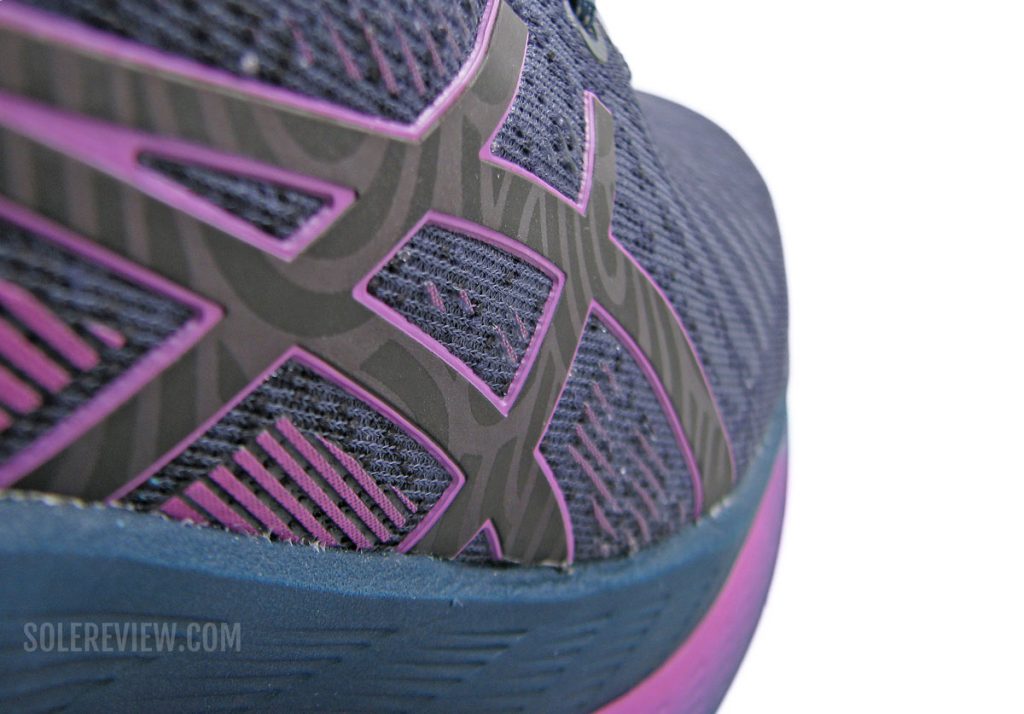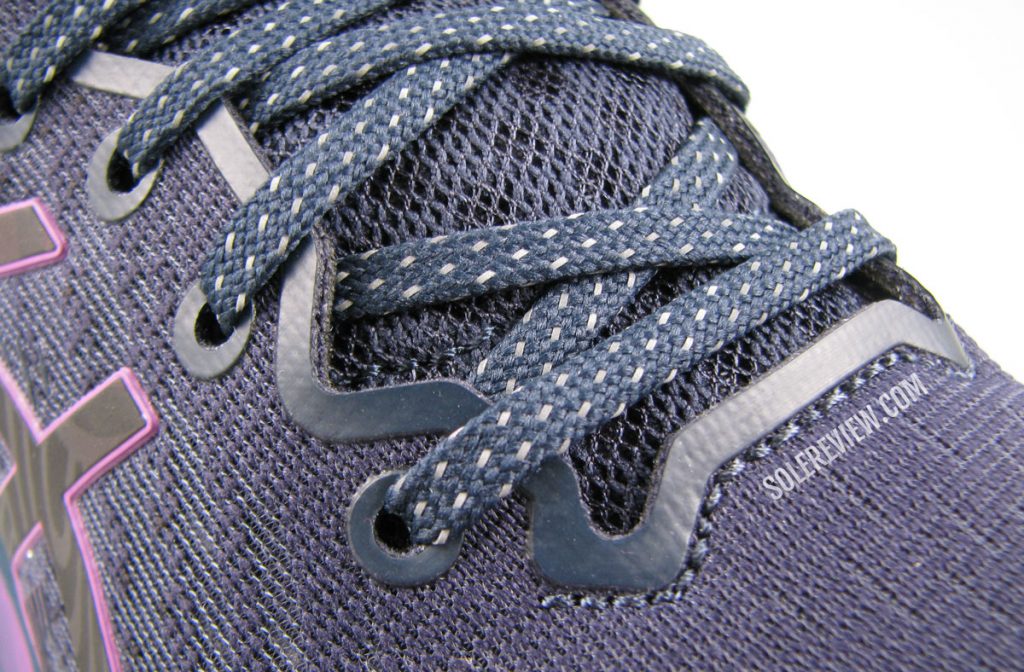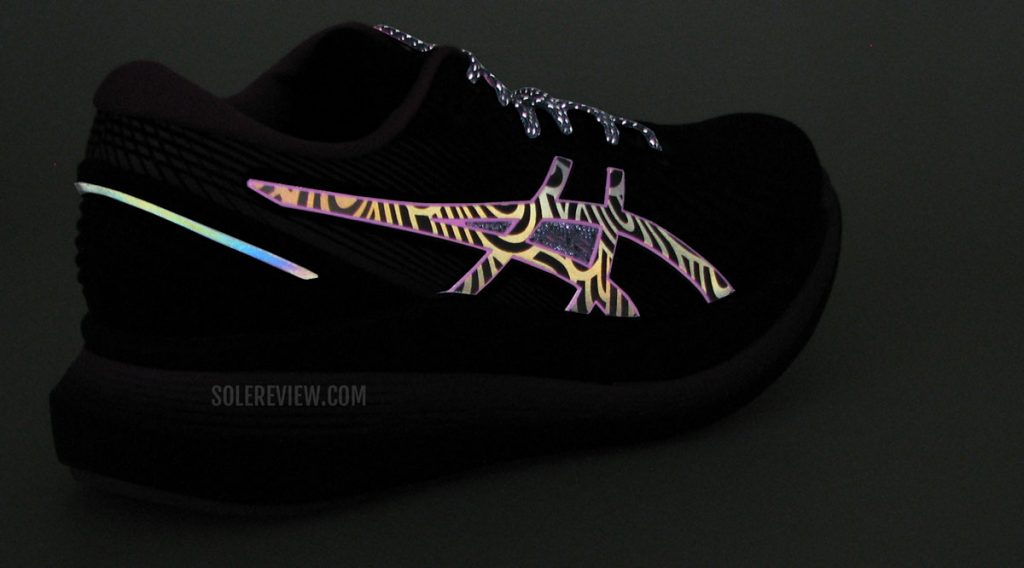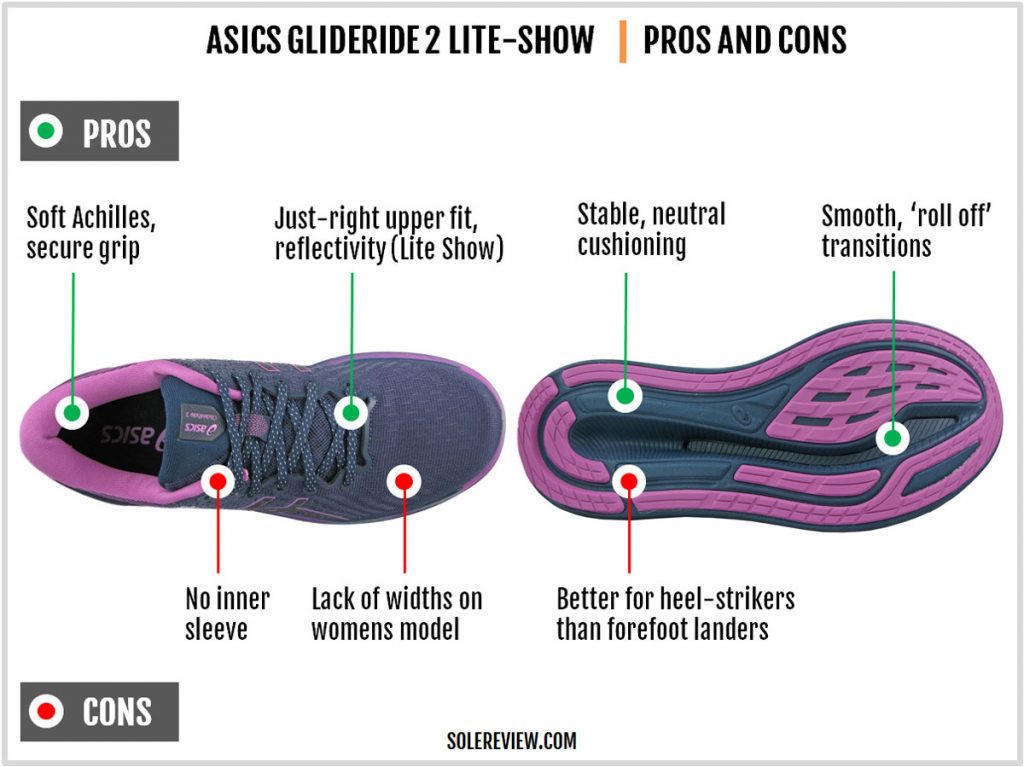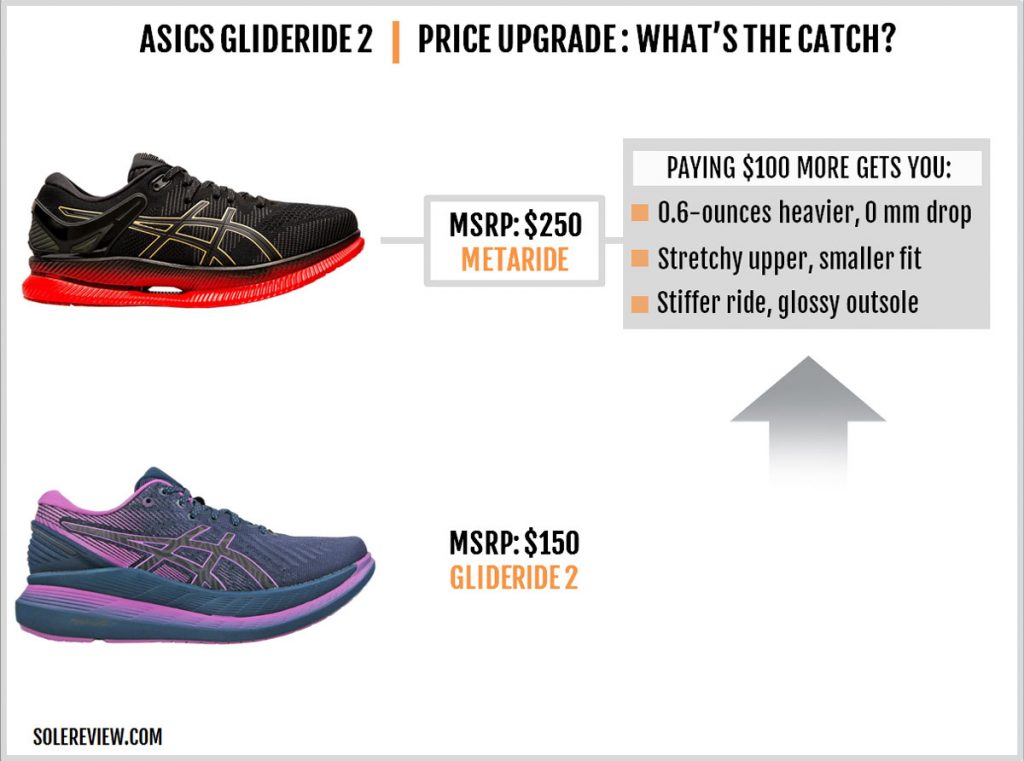INTRODUCTION
One of the subtle changes we’ve been making over the last few months is incorporating women-specific content. This was motivated by reader feedback, so here’s a thank you to everyone who takes the time to write to us.
However, Solereview has never used a women’s running shoe for any of our reviews, and that’s a shame. That’s going to change today; we’re going to use the women’s version of the Asics GlideRide 2 Lite-Show for our review.
The Glideride 2 is a good pick for a universal review, because the feature set doesn’t change based on gender. That isn’t the case for several Asics running shoes.
Both the men’s and women’s variants share a 5 mm heel-to-toe offset. This is unlike the Women’s Nimbus 23 that has a 3 mm higher offset and a 2 mm thicker heel than men’s; this difference affects the ride character.
Here, the midsole firmness and upper design are also consistent across genders.
And for this review, we chose to test the Lite-Show version of the Women’s GlideRide 2 that has additional reflectivity. Might as well do our first women’s running shoe review in style.
Our detailed review heaped praise on the first edition of the Glideride, and we hold the V2 in high regard as well.
With this shoe, Asics added value to the running shoe ecosystem with a unique spin on the plated midsole concept. Instead of a responsive ‘springboard’ effect that most brands were after, the Glideride made the transitions fun by making the forward rolls easier.
The rigid forefoot and high toe spring allowed the foot to breeze through the final stage of the gait cycle, which was preferable over the traditional way of having to work through the midsole foam.
The Glideride 2 retains most of the qualities that made the V1 an excellent running shoe. Having said that, the V2 has been redesigned from the ground up, and that results in several changes to the fit and feel.
The way we see it, the V2 is a refined – and leaner – version of the V1.
And who is the shoe for, exactly?
For all its hi-tech midsole plate and toe spring, the Glideride 2 is a versatile everyday trainer. It’s up for relaxed runs or faster training; and thanks to the generously cushioned midsole, high-mileage runs can be accomplished in comfort.
However, the Glideride’s eagerness to ‘roll forward’ the foot will feel very unfamiliar to runners who are new to such shoes.
THE ASICS GLIDERIDE 2 vs. GLIDERIDE 1
Based on the broader specs, one would assume that very little has changed. Both editions share an identical 5 mm heel-to-toe offset and weigh nearly the same.
The outsole groove looks familiar, and so does the dual-density midsole stack. The midsole and its upwardly curving toe spring also carry over from the V1.
Appearances can be misleading. While both versions deliver the cushioned ride and enjoyable roll-forward transitions, there’s a noticeable change in the ride quality.
The Glideride 2 no longer has a rearfoot Gel pad, and the lateral side of the midsole has more structure. The foam density is also firmer, and the midsole edge has a raised profile on both sides – a design feature that the previous model lacked.
With these tweaks, the Glideride 2 acquires a higher level of ‘neutralness’ and stability. The firmer ride also improves the transition quality, as there’s less ‘sink’ or bias under the heel. The firmer ride also does a better job of blending the plate into the foam stack.
The true-to-size profile and the snug upper fit are fairly similar to the outgoing model.
THE RIDE EXPERIENCE
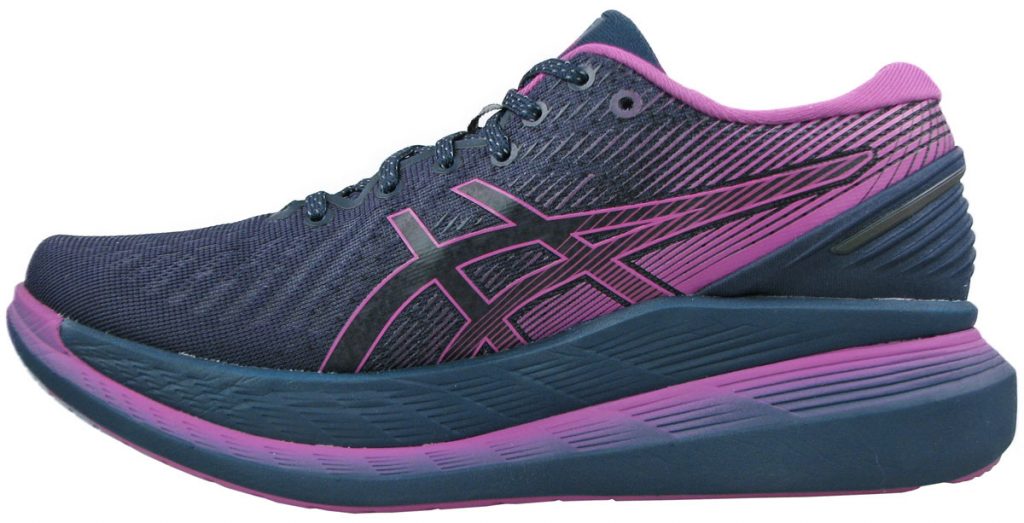
The Glideride 2 retains the rocker forefoot, but gets rid of the Gel pads and acquires raised sidewalls and a firmer ride.
Even though the Glideride 2’s stack height (31 mm rear, 26 mm front) is generous, that doesn’t result in a very soft ride experience.
In other words, the Glideride is nothing like the Novablast.
The only noticeable area of softness resides between the foot and midsole. A removable insole (the same as last year) and blown foam lasting create a plush footbed.
The rest of the midsole cushioning has a firm undertone that’s not as soft as the Glideride 1 due to the design tweaks.
For what it’s worth, the upper midsole is softer than the base layer.
Just like the previous model, the forefoot is stiff due to the internal plate (made of Nylon, we presume) and has a prominent rocker profile.
This combination of the high toe spring and stiff plate gives the Glideride its signature ride character. The rocker profile only applies to the front; the heel has a regular bevel.
The Glideride’s high forefoot rocker is a strange experience for runners who are accustomed to conventional running shoes. After all, regular shoes don’t ‘tip’ the foot forward – and that’s true even of many plated running shoes.
For example, neither the Hoka Carbon X and Asics Metaracer possess the distinct forward rolling transition of the Glideride. The plate makes the toe-off phase less of a chore, but lacks the exaggerated toe spring. The first time we came across this sensation was on the Mizuno Wave Prophecy, but that was a different time and place.
Most of the things that we said about the first edition of the Glideride apply to this model as well. The exaggerated toe spring results in a lower forefoot contact area, so the midsole works best for runners who either land mid and rearfoot.
During the final phase of the gait cycle, the foot ‘tips’ forward to make the roll-offs easier. On traditional running shoes, the foot has to work through the cushioning before pushing off.
While many running shoes achieve a similar effect by using a Carbon or Nylon plate (Nike Vaporfly, Saucony Endorphin), that usually comes at the cost of rearfoot stability. Asics focuses solely on the forefoot transitions; that’s the difference.
We could argue that shoes like the Hoka Carbon X2 behave similarly. After all, doesn’t the Hoka plate make the loading process better?
However, while the transitions feel quicker and more efficient on the Hoka Carbon X, the plate does not produce an exaggerated roll-forward effect.
So while the Glideride 2 isn’t a strict no-no for forefoot strikers, the midsole doesn’t deliver its best performance under the circumstances. A pure forefoot strike means that the loading happens at the base of the curve, with the rest of the forefoot midsole hanging in the air.
In short, there’s not enough contact surface for a proper forefoot landing.
On the other hand, runners who land behind the forefoot will benefit from a more stable ride and the enjoyable forward roll. It’s also worth underscoring that the transition groove is deepest under the heel and shallowest under the front.
Hence, runners who land rear or midfoot are in a better position to extract the complete Glideride experience.
The lack of versatility applies to only the foot-strike pattern. For all other use-cases, the Asics Glideride 2 is fairly versatile. Be it easy pace (6 min/km, 10 min/mile) or faster (4:30 min/km, 7 min/mile or up) runs, the Guidesole geometry works as intended.
Also, the 5 mm heel-to-toe offset is the Goldilocks zone between lower and mid offset models.
The high stack height packs ample cushioning for distance runs, and the plated forefoot saves you the trouble of laboring through the layers of foam. On peppier runs, the firm midsole and curved plate produce economical transitions.
One of the minor flaws of the V1 was its heel-to-forefoot transition quality. The previous model had a softer rearfoot, so there was a momentary hesitancy in the loading process as the foot transitioned from the soft heel to the plate-reinforced part of the midsole.
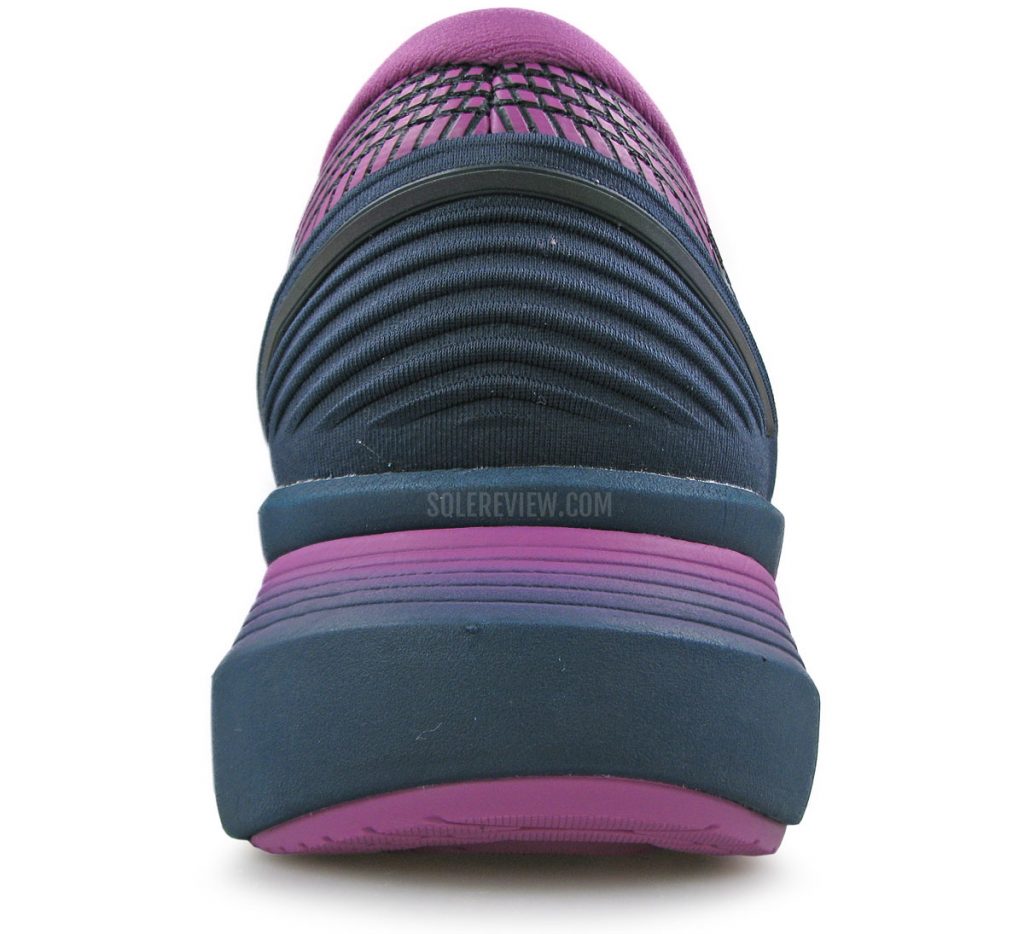
The V2’s midsole acquires improved stability by removing the V1’s Gel pads and filling up the lateral sidewall.
The V2’s ride has been re-tuned with three improvements. The firmer foam creates better cushioning consistency, while the filled-up midsole sidewalls add stability as well as better ‘neutralness’.
Lastly, the outsole redesign makes the transitions smoother. Unlike the V1’s single-piece layout, the new outsole is split into five pieces.
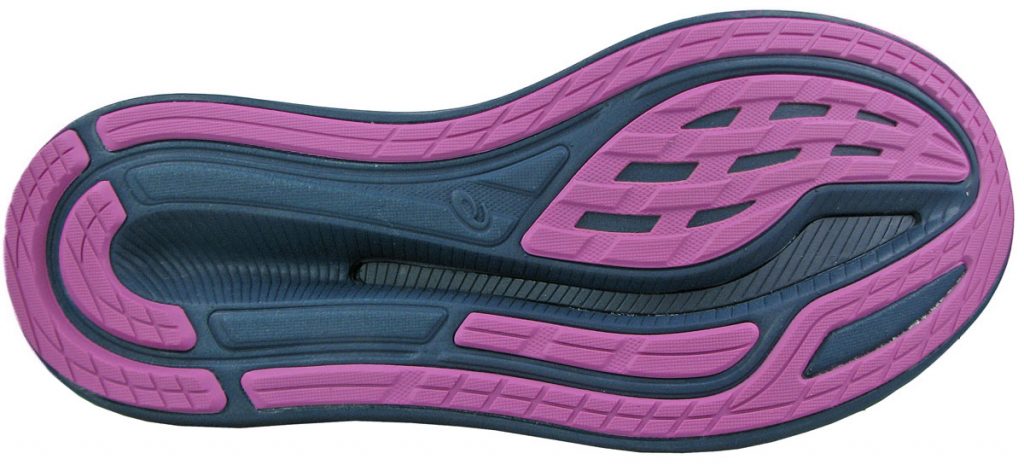
The new outsole has many ‘floating’ pieces. This is very unlike the V1’s one-piece geometry. The ride quality evolves as a result.
The strips under the heel are made of a hard-wearing rubber; the rest of the strips are made of a soft, blown rubber that blends seamlessly into the midsole.
Besides making the transitions smoother, the separated strips offer satisfactory multi-surface traction.
When combined with the deep transition groove on the outsole, the midsole delivers a smooth, supportive, and consistent ride that is also extremely neutral in its cushioning delivery.
The under-heel cavity and groove center the weight for superior tracking – this is what the original Guidance line should have felt like. Guess certain things do come full circle, after all.
Is there a downside to the recently acquired firmness? It depends on who’s asking.
The V1 was bouncier due to the softer Flytefoam and midsole design. With its firmer ride, the V2 dials down the springiness. But what the new midsole takes away in responsiveness, it gives back with improved stability and transitions. In our eyes, the new model is superior to the old one.
The firmness also does a better job of masking the presence of an internal plate.
Not that the V1 was lacking in this regard, but the Glideride 2 now achieves a Metaracer level of plate-foam integration.
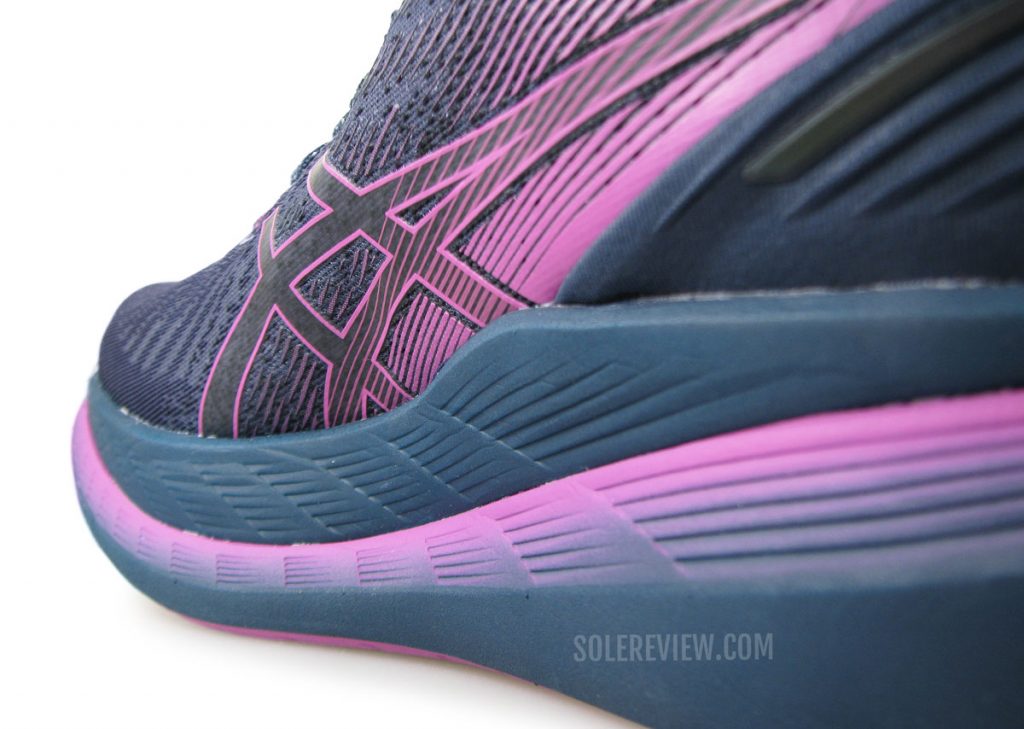
The midsole gets raised sidewalls. Yes, just like the Brooks Guiderails. As a result, the under-arch support is improved.
Also new are the inclusion of the raised midsole edges. The sidewalls curve upwards and flank the midfoot, thus resulting in a better cupping action – an effect that makes the upper fit better. These work well on many Brooks shoes (Guiderails), and it works here as well.
Given the shoe’s limitation around forefoot striking, another cushioned – and traditionally designed – Asics trainer adds rotational value. The Cumulus 23 would be our pick.
It’s a cushioned neutral trainer with a 10 mm offset, and is not as soft as the Nimbus 23. Originally, we thought of the Women’s Nimbus Lite 2, but its 13 heel drop is 8 mm higher than the Glideride 2. And if you can fit into a men’s Nimbus Lite 2 that has a 10 mm offset, here is our detailed review.
Besides the Cumulus, the Saucony Ride 14 and its firm ride is a sensible daily trainer pick that’s also forefoot-striking friendly. There’s another Saucony racer that we like – the Type A9.
Asics now has a decent spread of road racers, so take your pick. On the higher end, the plated Metaracer is an excellent speed shoe. Within the sub-$100 price segment, look no further than the Asics Hyper Speed.
For those who seek the hardcore racing flat experience, the Asics Tartheredge 2 has it in spades.
IS THE ASICS GLIDERIDE 2 DURABLE?
The midsole density and outsole geometry have a say in how long the Glideride 2 lasts. Based on our initial ownership experience, the Flytefoam midsole appears resistant to fatigue – just like the V1.
The outsole lug design is flat and articulated – thus resulting in a slower rate of wear and tear. Having smaller ‘floating’ strips on the foam midsole allows the outsole to blend into the midsole cushioning. This way, the rubber doesn’t take direct ‘hits’ from the road.
The layered upper has a robust build quality, so any premature material failure is unlikely to occur.
THE UPPER DESIGN AND FIT
There’s not much to write about the upper fit, and we say that in a nice way. The Glideride 2’s upper uses footwear best practices to create a fit character that’s almost without flaws.
The true-to-size upper achieves a near-perfect balance between a snug fit and interior comfort. The exterior shell is made of a single-piece mesh without any seams, so the insides fit smoothly without any hot spots.
When viewed from the outside, the mesh has a closed structure. Our picture from the inside shows how the vents work – they are not visible, but they do exist.
The upper isn’t overly breezy like the Metaracer, but there’s ample ventilation for all-season use. The V2’s midfoot runs cooler than the V1 due to the absence of felt-like layering.
The toe-box is nicely proportioned with sufficient height and width. While the forefoot isn’t spacious, it doesn’t feel too narrow. At the time of publishing this review, Asics offers a 2E (wide) option only on the Men’s model.
Hopefully, the 2E situation in the women’s Glideride changes soon.
The foam-padded heel and tongue create a comfortable grip around the ankles and over the instep. There’s no inner sleeve holding the tongue in place – yet.
We’ve recently seen other Asics models with an inner sleeve, so the next year’s version will likely feature one.
The tongue length is ideal, and rests just over the instep. It’s also effective at blocking the top-down lacing pressure, so the laces can be cinched to achieve a secure midfoot fit.
There’s adequate tongue length to accommodate the last row of heel lock lacing when deployed. There’s a minor degree of tongue slide, but it’s well within acceptable limits.
There’s a hard internal heel counter, so the rearfoot grip is excellent. The padded collar holds the foot in place, and the raised sidewalls create a cupping action around the midfoot. The removable insole and flared midsole create a satisfying sensation of under-arch support.
This is the ‘Lite-show’ variant, so reflectivity is abundant. The laces contain high-visibility accents, and so do the outer logo and heel trim. The inner logo isn’t reflective, but then, its inwards-facing position makes this a non-issue.
Though the mesh has a sheen, it isn’t reflective.
Even on their regular non-Lite Show models, Asics provides ample reflectivity – the Kayano Lite and Nimbus Lite 2 are proof.
PROS AND CONS
We view the tweaked ride quality as an improvement. The firmer foam stack and redesigned midsole improve the quality of transitions through a higher level of stability and neutral manners.
The firmer ride also creates a superior foam-plate integration; the multi-piece outsole also refines the ride character. If there’s any downside, it’s that the high toe spring isn’t ideal for forefoot-striking runners.
The supportive upper has a smooth and true-to-size fit that secures the foot without discomfort. The tongue slide is mild, but an inner sleeve would have been a nice touch.
At the time of publishing this review, a wide or narrow version isn’t optional in the women’s Glideride.
THE ASICS GLIDERIDE 2 vs. METARIDE
Unlike the GR2, the Metaride hasn’t been updated so far. Is it the end of the road for this concept shoe? We don’t know. Asics could pull a surprise update.
But for now, we just have the Metaride to compare the Glideride 2 with. Between the two, there are three differences worth mentioning. The first is the 0 mm heel-to-toe offset midsole with a uniform stack height of 30 mm. (31 mm for the men’s model)
Two, the Metaride outweighs the Glideride by 0.6-ounces. Three, the Metaride has a softer ride due to its heel Gel pad, grooved sidewalls, and softer density foam.
So while the Meta’s Guidesole geometry delivers a similar ‘roll forward’ transition as the Glideride, it does so with a relaxed softness that takes more effort to power through.
Finally, the trim level is higher on the Meta. The upper is more blingy; the heel has a molded counter, the logos are glossy, and the upper is softer with slightly more room than the Glide. Even the outsole has a sheeny texture that grips better over smooth surfaces.
Just watch out for the fit; the Metaride fits a half size smaller than its stated size.
So what should you do? Get the Glideride 2, which is the superior running shoe of the two – the Metaride ain’t worth the cash.
Do you own this shoe? Improve this review by sharing your insights – submit a review here.

